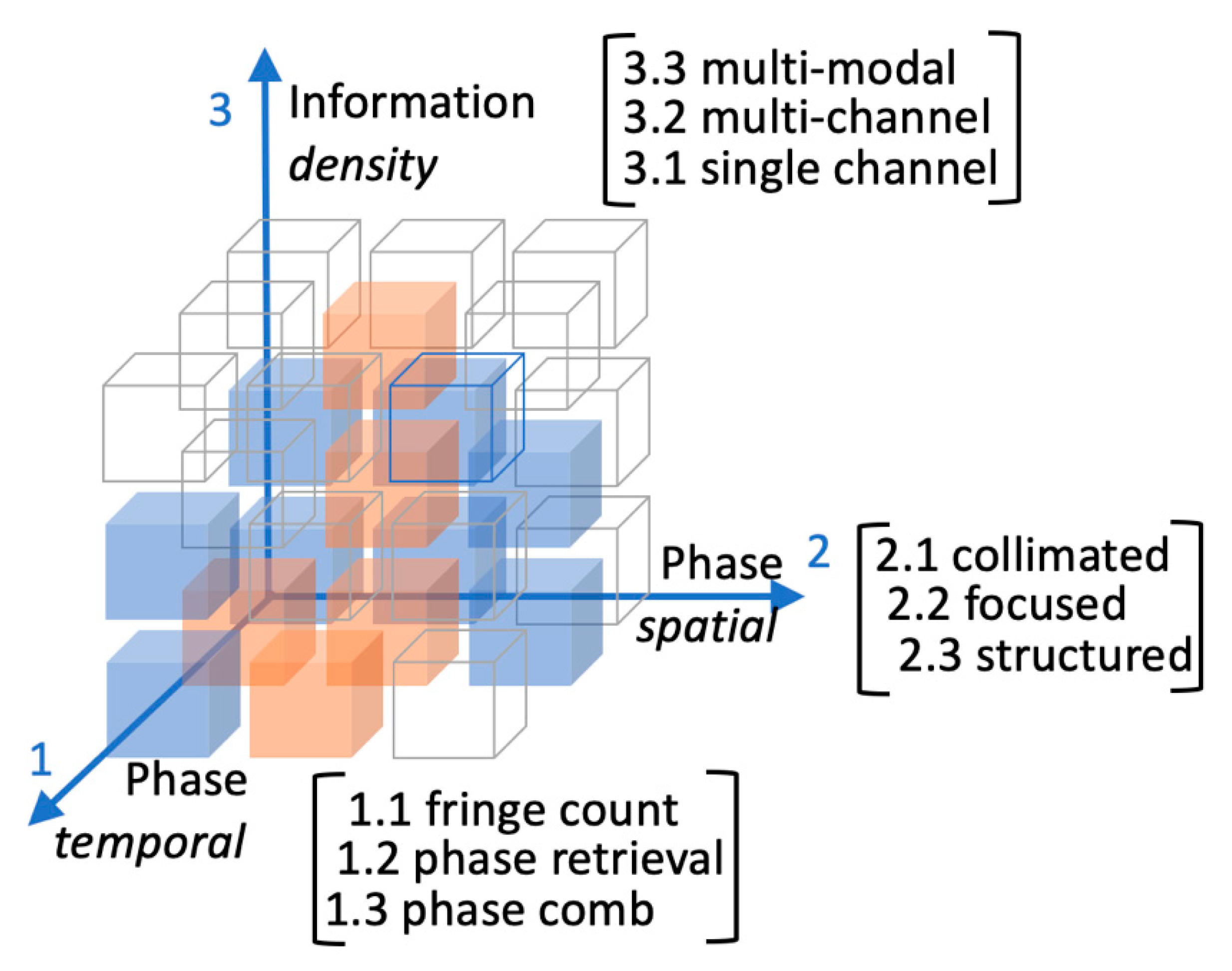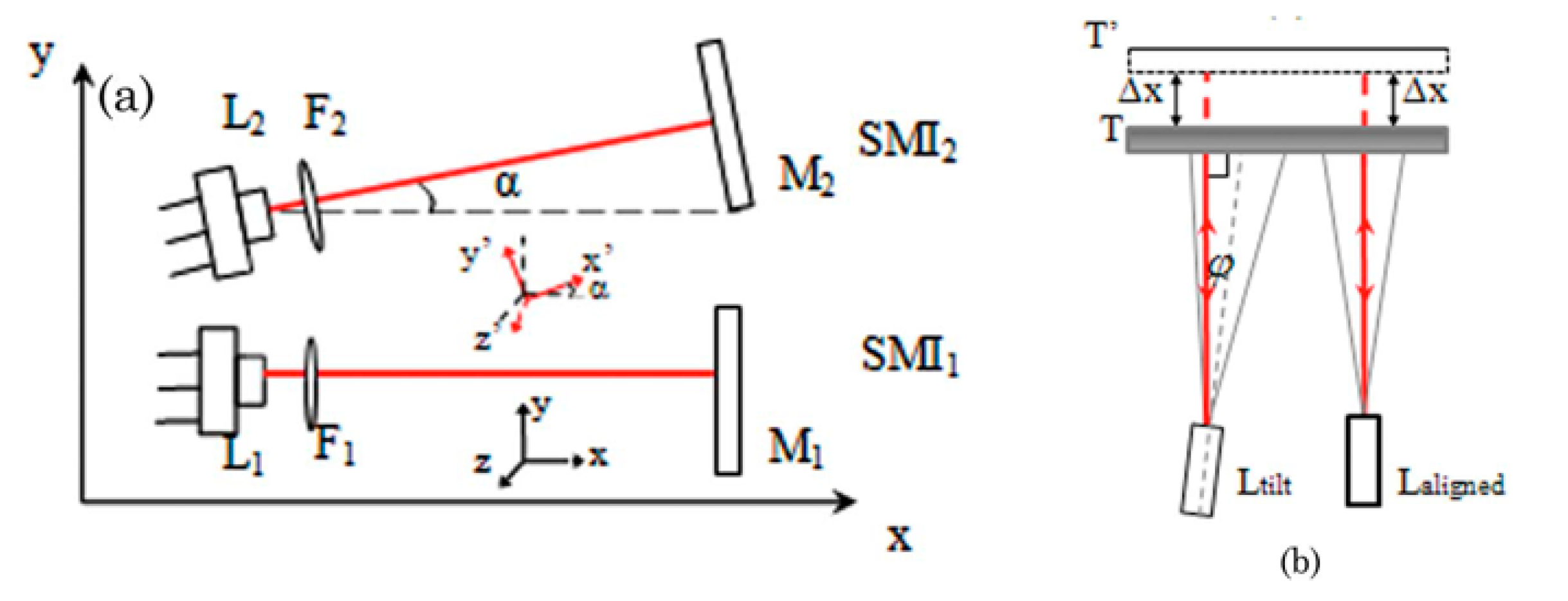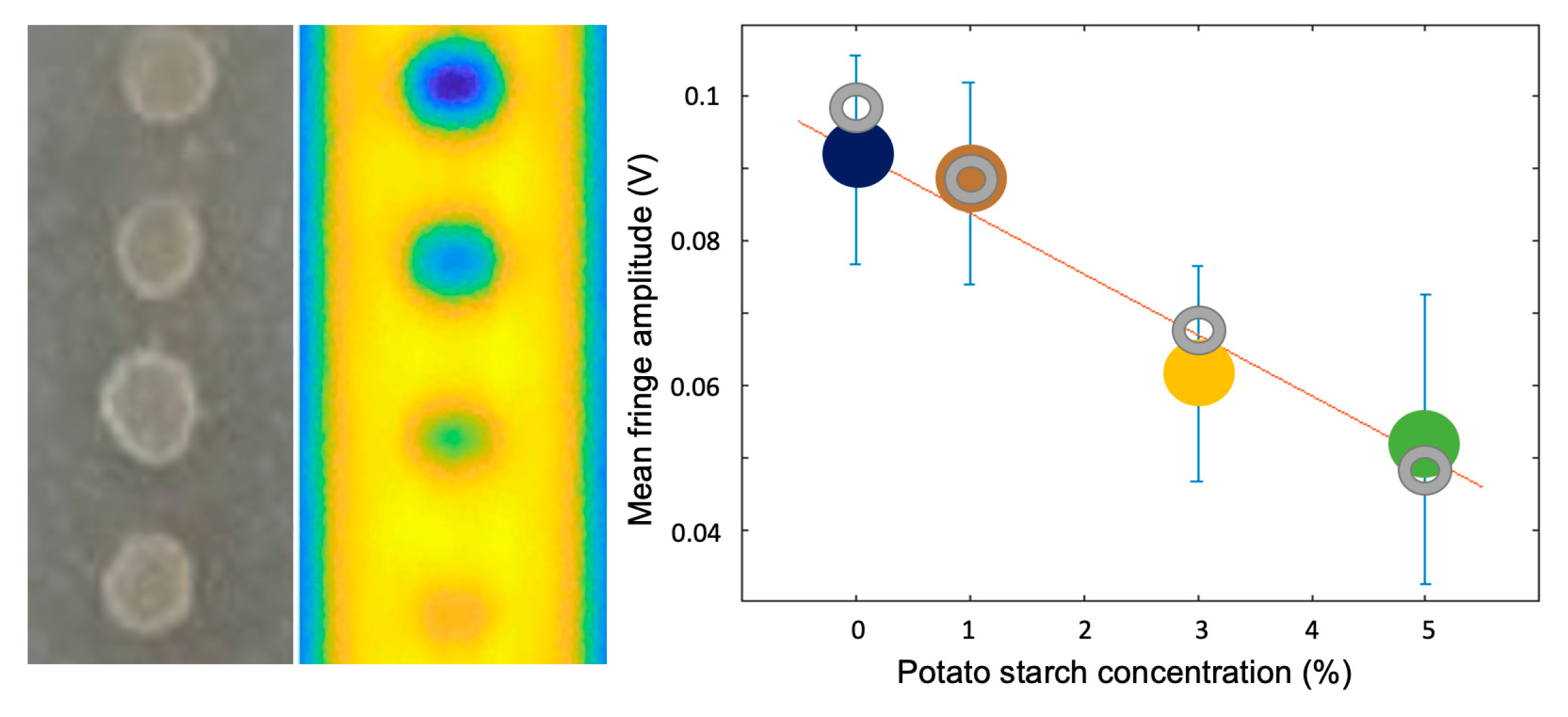Versatile Multimodality Imaging System Based on Detectorless and Scanless Optical Feedback Interferometry—A Retrospective Overview for A Prospective Vision
Abstract
:1. Introduction
2. Basic Principles and Modeling Equations
3. Single Mode Feedback Sensors
3.1. Optical Feedback Sensing in Semiconductor Diode Lasers
3.2. Optical Feedback Sensing in Quantum Cascade Lasers
4. Single Mode Feedback Imaging
4.1. Index Contrast
4.2. Absorption Contrast
4.3. Mixed Contrast
5. Multimode Feedback towards Scanless Imaging
6. Conclusions
7. Patents
Funding
Acknowledgments
Conflicts of Interest
References
- Petermann, K. External optical feedback phenomena in semiconductor lasers. IEEE J. Sel. Top. Quantum. Electron. 1995, 1, 480–489. [Google Scholar] [CrossRef]
- Donati, S. Developing self-mixing interferometry for instrumentation and measurements. Laser Phot. Rev. 2012, 6, 393–417. [Google Scholar] [CrossRef]
- Taimre, T.; Nikolić, M.; Bertling, K.; Lim, Y.L.; Bosch, T.; Rakić, A.D. Laser feedback interferometry: A tutorial on the self-mixing effect for coherent sensing. Adv. Opt. Photon. 2015, 7, 570–631. [Google Scholar] [CrossRef]
- Perchoux, J.; Quotb, A.; Atashkhooei, R.; Azcona, F.J.; Ramírez-Miquet, E.E.; Bernal, O.; Jha, A.; Luna-Arriaga, A.; Yanez, C.; Caum, J.; et al. Current Developments on Optical Feedback Interferometry as an All-Optical Sensor for Biomedical Applications. Sensors 2016, 16, 694. [Google Scholar] [CrossRef]
- Rakić, A.D.; Taimre, T.; Bertling, K.; Lim, Y.L.; Dean, P.; Valavanis, A.; Indjin, D. Sensing and imaging using laser feedback interferometry with quantum cascade lasers. Appl. Phys. Rev. 2019, 6, 021320. [Google Scholar] [CrossRef] [Green Version]
- Kane, D.M.; Shore, K.A. Unlocking Dynamical Diversity: Optical Feedback Effects on Semiconductor Lasers; John Wiley & Sons Ltd.: Chicherster, UK, 2005. [Google Scholar]
- Jumpertz, L. Nonlinear Photonics in Mid-infrared Quantum Cascade Lasers; Springer International Publishing: Berlin/Heidelberg, Germany, 2017. [Google Scholar]
- Donati, S. Laser interferometry. In Electro-optical instrumentation: Sensing and measuring with lasers; Prentice Hall Professional Technical Reference, Pearson Education, Inc.: Upper Saddle River, NJ, USA, 2004; pp. 89–180. [Google Scholar]
- Bosch, T.; Bès, C.; Scalise, L.; Plantier, G. Optical Feedback Interferometry. In Encyclopedia of Sensors; American Scientific Publishers: Valencia, CA, USA, 2006; pp. 1–20. [Google Scholar]
- Ohtsubo, J. Theory of Optical Feedback in Semiconductor Lasers. In Semiconductor Lasers. Stability, Instability and Chaos; Springer: Berlin/Heidelberg, Germany, 2017; pp. 83–112. [Google Scholar]
- Brunner, D.; Luna, R.; Delhom i Latorre, A.; Porte, X.; Fischer, I. Semiconductor laser linewidth reduction by six orders of magnitude via delayed optical feedback. Opt. Lett. 2017, 42, 163–166. [Google Scholar] [CrossRef] [PubMed]
- Locquet, A. Routes to chaos of a semiconductor laser subjected to external optical feedback: A review. Photonics 2020, 7, 22. [Google Scholar] [CrossRef] [Green Version]
- Giuliani, G.; Norgia, M.; Donati, S.; Bosch, T. Self-Mixing Technique for Sensing Applications. J. Optics A 2002, 4, 283–294. [Google Scholar] [CrossRef] [Green Version]
- Lui, H.S.; Taimre, T.; Bertling, K.; Lim, Y.L.; Dean, P.; Khanna, S.P.; Lachab, M.; Valavanis, A.; Indjin, D.; Linfield, E.H.; et al. Terahertz inverse synthetic aperture radar imaging using self-mixing interferometry with a quantum cascade laser. Opt. Lett. 2014, 39, 2629–2632. [Google Scholar] [CrossRef] [Green Version]
- Giordano, M.C.; Mastel, S.; Liewald, C.; Columbo, L.L.; Brambilla, M.; Viti, L.; Politano, A.; Zhang, K.; Li, L.; Davies, A.G.; et al. Phase-resolved terahertz self-detection near-field microscopy. Opt. Expr. 2018, 26, 18423–18435. [Google Scholar] [CrossRef] [Green Version]
- Ehtesham, A.; Zabit, U.; Bernal, O.D.; Raja, G.; Bosch, T. Analysis and Implementation of a Direct Phase Unwrapping Method for Displacement Measurement Using Self-Mixing Interferometry. IEEE Sens. J. 2017, 17, 7425–7432. [Google Scholar] [CrossRef] [Green Version]
- Giuliani, G.; Bozzi-Pietra, S.; Donati, S. Self-mixing laser diode vibrometer. Meas. Sci. Technol. 2002, 14, 24. [Google Scholar] [CrossRef]
- Ottomaniello, A.; Keeley, J.; Rubino, P.; Li, L.; Cecchini, M.; Linfield, E.H.; Davies, A.G.; Dean, P.; Pitanti, A.; Tredicucci, A. Optomechanical response with nanometer resolution in the self-mixing signal of a terahertz quantum cascade laser. Opt. Lett. 2019, 44, 5563–5666. [Google Scholar] [CrossRef] [PubMed]
- Donati, S.; Rossi, D.; Norgia, M. Single Channel Self-Mixing Interferometer Measures Simultaneously Displacement and Tilt and Yaw Angles of a Reflective Target. IEEE J. Quantum Electron. 2015, 51, 1–8. [Google Scholar] [CrossRef]
- Zabit, U.; Shaheen, K.; Naveed, M.; Bernal, O.D.; Bosch, T. Automatic Detection of Multi-Modality in Self-Mixing Interferometer. IEEE Sens. J. 2018, 18, 9195–9202. [Google Scholar] [CrossRef] [Green Version]
- Mowla, A.; Bertling, K.; Wilson, S.J.; Rakić, A.D. Dual-Modality Confocal Laser Feedback Tomography for Highly Scattering Medium. IEEE Sens. J. 2019, 19, 6134–6140. [Google Scholar] [CrossRef]
- Lang, R.; Kobayashi, K. External optical feedback effects on semiconductor injection laser properties. IEEE J. Quantum Electron. 1980, 16, 347–355. [Google Scholar] [CrossRef]
- Tkach, R.W.; Chraplyvy, A.R. Regimes of feedback effects in 1.5 μm distributed feedback laser. IEEE J. Light. Technol. 1986, LT-4, 1655–1661. [Google Scholar] [CrossRef]
- Acket, G.A.; Lenstra, D.; den Boef, J.; Verbeek, B.H. The influence of feedback intensity on longitudinal mode properties and optical noise in index guided semiconductor lasers. IEEE J. Quant. Electron. 1984, 20, 1163–1169. [Google Scholar] [CrossRef]
- Henry, C.H. Theory of the linewidth of semiconductor lasers. IEEE J. Quant. Electron. 1982, 18, 259–264. [Google Scholar] [CrossRef]
- Columbo, L.L.; Brambilla, M.; Dabbicco, M.; Scamarcio, G. Self-mixig in multi-transverse mode semiconductor lasers: Model and potential application to multiparametric sensing. Opt. Expr. 2012, 20, 6286–6305. [Google Scholar] [CrossRef]
- Columbo, L.L.; Brambilla, M. Multimode regimes in quantum cascade lasers with optical feedback. Opt. Expr. 2014, 22, 10105–10118. [Google Scholar] [CrossRef] [PubMed]
- Mezzapesa, F.P.; Columbo, L.L.; Brambilla, M.; Dabbicco, M.; Borri, S.; Vitiello, M.S.; Beere, H.S.; Ritchie, D.A.; Scamarcio, G. Intrinsic stability of quantum cascade lasers against optical feedback. Opt. Expr. 2013, 21, 13748–13757. [Google Scholar] [CrossRef] [PubMed]
- Mezzapesa, F.P.; Columbo, L.L.; De Risi, G.; Brambilla, M.; Dabbicco, M.; Spagnolo, V.; Scamarcio, G. Nanoscale displacement sensing based on nonlinear frequency mixing in quantum cascade lasers. IEEE J. Sel. Topics Quantum Electron. 2015, 21, 1200908. [Google Scholar] [CrossRef] [Green Version]
- Mezzapesa, F.P.; Ancona, A.; Sibillano, T.; De Lucia, F.; Dabbicco, M.; Lugarà, P.M.; Scamarcio, G. High-resolution monitoring of the hole depth during ultrafast laser ablation drilling by diode-laser self-mixing interferometry. Opt. Lett. 2011, 36, 822–824. [Google Scholar] [CrossRef] [PubMed]
- Mezzapesa, F.P.; Sibillano, T.; Di Niso, F.; Ancona, A.; Lugarà, P.M.; De Lucia, F.; Dabbicco, M.; Scamarcio, G. Real time ablation rate measurement during high aspect-ratioo hole drilling with a 120-ps fiber laser. Opt. Expr. 2012, 20, 663–671. [Google Scholar] [CrossRef] [PubMed]
- Ottonelli, S.; Dabbicco, M.; De Lucia, F.; Scamarcio, G. Simultaneous measurement of linear and transverse displacements by laser self-mixing. Appl. Opt. 2009, 48, 1784–1789. [Google Scholar] [CrossRef]
- Ottonelli, S.; Dabbicco, M.; De Lucia, F.; di Vietro, M.; Scamarcio, G. Laser self-mixing interferometry for mechatronics applications. Sensors 2009, 9, 3527–3548. [Google Scholar] [CrossRef] [Green Version]
- Zabit, U.; Atashkhooei, R.; Bosch, T.; Royo, S.; Bony, F.; Rakic, A.D. Adaptive self-mixing vibrometer based on a liquid lens. Opt. Lett. 2010, 35, 1278–1280. [Google Scholar] [CrossRef]
- De Lucia, F.; Dabbicco, M.; Putignano, M.; di Vietro, M.; Ottonelli, S.; Scamarcio, G. Laser self-mixing interferometry in the Gaussian beam approximation: Experiments and theory. Opt. Expr. 2010, 18, 10323–10333. [Google Scholar] [CrossRef]
- Donati, S.; Horng, R. The Diagram of Feedback Regimes Revisited. IEEE J. Sel. Topics Quantum Electron. 2013, 19, 1500309. [Google Scholar] [CrossRef] [Green Version]
- Jumpertz, L.; Carras, M.; Schires, K.; Grillot, F. Regimes of external optical feedback in 5.6 μm distributed feedback mid-infrared quantum cascade lasers. Appl. Phys. Lett. 2014, 105, 131112. [Google Scholar] [CrossRef] [Green Version]
- Cardilli, M.C.; Dabbicco, M.; Mezzapesa, F.P.; Scamarcio, G. Linewidth measurement of mid infrared quantum cascade lasers by optical feedback interferometry. Appl. Phys. Lett. 2016, 108, 031105. [Google Scholar] [CrossRef]
- Mezzapesa, F.P.; Columbo, L.L.; Dabbicco, M.; Brambilla, M.; Scamarcio, G. QCL-based nonlinear sensing of independent target dynamics. Opt. Expr. 2014, 22, 5867–5874. [Google Scholar] [CrossRef]
- Rakić, A.D.; Taimre, T.; Bertling, K.; Lim, Y.L.; Dean, P.; Indjin, D.; Ikonić, Z.; Harrison, P.; Valavanis, A.; Khanna, S.P.; et al. Swept-frequency feedback interferometry using terahertz frequency QCLs: A method for imaging and materials analysis. Opt. Expr. 2013, 21, 22194–22205. [Google Scholar] [CrossRef]
- Dabbicco, M.; Colafemmina, G. Multi-wavelength imaging of tissue phantoms by optical feedback interferometry. In Nanoscale Imaging, Sensing, and Actuation for Biomedical Applications XVI, Proceedings of the SPIE n. 10891, San Francisco, CA, USA, 2–7 February 2019; International Society for Optics and Photonics: Bellingham, WA, USA, 2019. [Google Scholar]
- Dean, P.; Valavanis, A.; Keeley, J.; Bertling, K.; Lim, Y.L.; Alhathlool, R.; Chowdhury, S.; Taimre, T.; Li, L.H.; Indjin, D.; et al. Coherent three-dimensional terahertz imaging through self-mixing in a quantum cascade laser. Appl. Phys. Lett. 2013, 103, 181112. [Google Scholar] [CrossRef] [Green Version]
- Mezzapesa, F.P.; Petruzzella, M.; Dabbicco, M.; Beere, H.E.; Ritchie, D.A.; Vitiello, M.S.; Scamarcio, G. Continuous-wave reflection imaging using optical feedback interferometry in Terahertz and mid-infrared quantum cascade lasers. IEEE Trans. Terahertz Sci. Tech. 2014, 4, 631–634. [Google Scholar] [CrossRef]
- Blaize, S.; Bérenguier, B.; Stéfanon, I.; Bruyant, A.; Lérondel, G.; Royer, P.; Hugon, O.; Jacquin, O.; Lacot, E. Phase sensitive optical near-field mapping using frequency-shifted laser optical feedback interferometry. Opt. Expr. 2008, 16, 11718–11726. [Google Scholar] [CrossRef]
- Mezzapesa, F.P.; Columbo, L.L.; Brambilla, M.; Dabbicco, M.; Vitiello, M.S.; Scamarcio, G. Imaging of free carriers in semiconductors via optical feedback in THz quantum cascade lasers. Appl. Phys. Lett. 2014, 104, 041112. [Google Scholar] [CrossRef]
- Glastre, W.; Hugon, O.; Jacquin, O.; Guillet de Chatellus, H.; Lacot, E. Demonstration of a plenoptic microscope based on laser optical feedback imaging. Opt. Expr. 2013, 21, 7294–7303. [Google Scholar] [CrossRef] [Green Version]
- Bertling, K.; Perchoux, J.; Taimre, T.; Malkin, R.; Robert, D.; Rakić, A.D.; Bosch, T. Imaging of acoustic fields using optical feedback interferometry. Opt. Expr. 2014, 22, 30346–30356. [Google Scholar] [CrossRef] [PubMed] [Green Version]
- Zhu, K.; Lu, Y.; Zhang, S.; Ruan, H.; Usuki, S.; Tan, Y. Ultrasound modulated laser confocal feedback imaging inside turbid media. Opt. Lett. 2018, 43, 207–1210. [Google Scholar] [CrossRef]
- Dean, P.; Valavanis, A.; Keeley, J.; Bertling, K.; Lim, Y.L.; Alhathlool, R.; Burnett, A.D.; Li, L.H.; Khanna, S.P.; Indjin, D.; et al. Terahertz imaging using quantum cascade lasers—A review of systems and applications. J. Phys. D Appl. Phys. 2014, 47, 374008. [Google Scholar] [CrossRef]
- Tucker, J.R.; Rakić, A.D.; O’Brien, C.J.; Zvyagin, A.V. Effect of multiple transverse modes in self-mixing sensors based on vertical-cavity surface-emitting lasers. Appl. Opt. 2007, 46, 611–619. [Google Scholar] [CrossRef] [PubMed] [Green Version]
- Dai, X.; Wang, M.; Zhou, C. Multiplexing Self-Mixing Interference in Fiber Ring Lasers. IEEE Photon. Technol. Lett. 2010, 22, 1619–1621. [Google Scholar] [CrossRef]
- Zhang, S.; Zhang, S.; Tan, Y.; Sun, L. Self-mixing interferometry with mutual independent orthogonal polarized light. Opt. Lett. 2016, 41, 844–846. [Google Scholar] [CrossRef] [PubMed]
- Columbo, L.L.; De Lucia, F.; Brambilla, M.; Dabbicco, M. Self-mixing in VCSELs for multi-parametric sensing applications: Theory and experiment. In Semiconductor Laser and Laser Dynamics V; Proceedings of SPIE n. 8432, Brussels, Belgium, 16–19 April 2012; International Society for Optics and Photonics: Bellingham, WA, USA, 2012. [Google Scholar]
- Dabbicco, M.; Maggipinto, T.; Brambilla, M. Optical bistability and stationary patterns in photonic-crystal vertical-cavity surface-emitting lasers. Appl. Phys. Lett. 2005, 86, 0211116. [Google Scholar] [CrossRef]
- Kao, T.; Reno, J.; Hu, Q. Phase-locked laser arrays through global antenna mutual coupling. Nature Photon. 2016, 10, 541–546. [Google Scholar] [CrossRef]
- Orenstein, M.; Kapon, E.; Stoffel, N.G.; Harbison, J.P.; Florez, L.T.; Wullert, J. Two-dimensional phase-locked arrays of vertical-cavity semiconductor lasers by mirror reflectivity modulation. Appl. Phys. Lett. 1991, 58, 804–806. [Google Scholar] [CrossRef]
- Lim, Y.L.; Nikolic, M.; Bertling, K.; Kliese, R.; Rakić, A.D. Self-mixing imaging sensor using a monolithic VCSEL array with parallel readout. Opt. Expr. 2009, 17, 5517–5525. [Google Scholar] [CrossRef]
- Lee, B.G.; Belkin, M.A.; Pflugl, C.; Diehl, L.; Zhang, H.A.; Audet, R.M.; MacArthur, J.; Bour, D.P.; Corzine, S.W.; Hofler, G.E.; et al. DFB Quantum Cascade Laser Arrays. IEEE J. Quantum Electron. 2009, 45, 554–565. [Google Scholar] [CrossRef] [Green Version]
- Rani, M.; Dhok, S.B.; Deshmukh, R.B. A Systematic Review of Compressive Sensing: Concepts, Implementations and Applications. IEEE Access 2018, 6, 4875–4894. [Google Scholar] [CrossRef]
- Lupo, A.; Sylos Labini, P.; Dabbicco, M. Scanless and detectorless imaging by optical feedback interferometry. In Proceedings of the Frontiers in Optics + Laser Science APS/DLS, online, 14–17 September 2020. accepted for publication. [Google Scholar]
- Mezzapesa, F.P.; Columbo, L.L.; Rizza, C.; Brambilla, M.; Ciattoni, A.; Dabbicco, M.; Vitiello, M.S.; Scamarcio, G. Photo-designed metamaterials induce modulation of CW terahertz quantum cascade lasers. Sci. Rep. 2015, 5, 16207. [Google Scholar] [CrossRef] [PubMed] [Green Version]
- Shnitser, P.; Miller, D.; Ulmer, C.T.; Romanov, V.; Grubsky, V. Robotic autonomous navigation and orientation tracking system and methods. Patent US 10207410B1, 7 January 2019. [Google Scholar]
- O’Brien, D.; Hegarty, S.P.; Huyet, G.; Uskov, A.V. Sensitivity of quantum-dot semiconductor lasers to optical feedback. Opt. Lett. 2004, 29, 1072–1074. [Google Scholar] [CrossRef]
- Donati, S.; Norgia, M. Self-Mixing Interferometry for Biomedical Signals Sensing. IEEE J. Sel. Top. Quantum Electron. 2014, 20, 104–111. [Google Scholar] [CrossRef]













Publisher’s Note: MDPI stays neutral with regard to jurisdictional claims in published maps and institutional affiliations. |
© 2020 by the authors. Licensee MDPI, Basel, Switzerland. This article is an open access article distributed under the terms and conditions of the Creative Commons Attribution (CC BY) license (http://creativecommons.org/licenses/by/4.0/).
Share and Cite
Brambilla, M.; Columbo, L.L.; Dabbicco, M.; De Lucia, F.; Mezzapesa, F.P.; Scamarcio, G. Versatile Multimodality Imaging System Based on Detectorless and Scanless Optical Feedback Interferometry—A Retrospective Overview for A Prospective Vision. Sensors 2020, 20, 5930. https://doi.org/10.3390/s20205930
Brambilla M, Columbo LL, Dabbicco M, De Lucia F, Mezzapesa FP, Scamarcio G. Versatile Multimodality Imaging System Based on Detectorless and Scanless Optical Feedback Interferometry—A Retrospective Overview for A Prospective Vision. Sensors. 2020; 20(20):5930. https://doi.org/10.3390/s20205930
Chicago/Turabian StyleBrambilla, Massimo, Lorenzo Luigi Columbo, Maurizio Dabbicco, Francesco De Lucia, Francesco Paolo Mezzapesa, and Gaetano Scamarcio. 2020. "Versatile Multimodality Imaging System Based on Detectorless and Scanless Optical Feedback Interferometry—A Retrospective Overview for A Prospective Vision" Sensors 20, no. 20: 5930. https://doi.org/10.3390/s20205930





